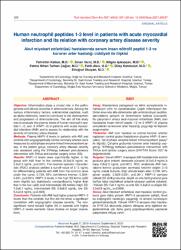Human neutrophil peptides 1-3 level in patients with acute myocardial infarction and its relation with coronary artery disease severity

View/
Date
2021Author
Katkat, FahrettinVarol, Sinan
Işıksaçan, Nilgün
Turhan Çağlar, Fatma Nihan
Akın, Fatih
Karabulut, Dilay
Okuyan, Ertuğrul
Metadata
Show full item recordCitation
Katkat F, Varol S, Işıksaçan N, Turhan Çağlar FN, Akın F, Karabulut D, Okuyan E. Human neutrophil peptides 1-3 level in patients with acute myocardial infarction and its relation with coronary artery disease severity. Turk Kardiyol Dern Ars. 2021 Mar;49(2):120-126. doi: 10.5543/tkda.2021.99537. PMID: 33709917.Abstract
Objective: Inflammation plays a crucial role in the pathogenesis and clinical outcome of atherosclerosis. Among the various inflammatory factors, antimicrobial peptides, such as alpha-defensins, seem to contribute to the development and progression of atherosclerosis. The aim of this study was to evaluate the plasma levels of human neutrophil peptide-1, -2, and -3 (HNP1-3) in patients with acute myocardial infarction (AMI) and to assess its relationship with the severity of coronary artery disease.
Methods: lasma HNP1-3 levels in patients with AMI and controls with angiographically normal coronary arteries were measured by solid-phase enzyme-linked immunosorbent assay. In the patient group, coronary artery disease severity was assessed using the SYNergy between percutaneous intervention with TAXus and cardiac surgery score (SS).
Results: HNP1-3 levels were significantly higher in the group with AMI than in the controls (6.5±5.8 ng/mL vs. 2.8±2.5 ng/mL, p<0.001). The receiver operator characteristic (ROC) analysis yielded a cut-off value of 3.13 ng/mL for differentiating patients with AMI from the controls (area under the curve: 0.739, 95% confidence interval: 0.629-0.831, p<0.001). HNP1-3 levels in the high SS tertile (≥33) were slightly but statistically nonsignificantly higher than that in the low (≤22) and intermediate SS tertiles (high SS: 7.0±6.1 ng/mL, intermediate SS: 5.9±6.2 ng/mL, low SS: 5.3±3.8 ng/mL; p=0.639).
Conclusion: Patients with AMI had higher plasma HNP1-3 levels than the controls, but this did not show a significant correlation with angiographic disease severity. The nonsignificant trend toward higher SS in patients with higher HNP1-3 levels warrants future studies on larger populations.
Source
Archives of the Turkish Society of CardiologyVolume
49Issue
2URI
https://archivestsc.com/jvi.aspx?un=TKDA-99537&volume=49&issue=2https://hdl.handle.net/20.500.12809/9014

















